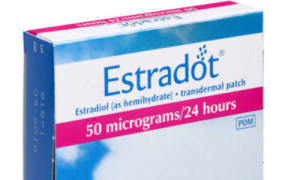
Pharmac limits funding to two patches per week but says it is reconsidering this restriction. Photo: BMJ
The shortage of hormone replacement therapy patches is getting worse, and Pharmac has been too slow to act, doctors specialising in women's health say.
Two of the most popular dosage patches - used to mitigate the symptoms of estrogen deficiency - are unavailable nationwide, leaving women shopping around different pharmacies, and some having to pay for extra patches to reach their required prescribed dose.
Pharmac limits funding to two patches per week but said it was reconsidering this restriction, as well as moving to fund alternatives such as estrogen gels.
The funding agency said demand for HRT patches had more than doubled in the past three and the shortage was likely to continue into next year.
There were a number of factors behind the shortage, ERH Associates endocrinologist Dr Megan Ogilvie told Nine to Noon.
"Novartis, which manufactures the gold standard product Estradot, is having manufacturing issues, and there has been a significant rise in demand globally for this product as the superiority of the transdermal approach has been recognised.
"But it is compounded in New Zealand by a lack of gels which would relieve significant pressure on the patches," Ogilvie said.
In a statement, Pharmac said it was "exploring if there are other presentations or products that it can secure and fund".
Ogilvie said more funding for alternatives such as gels would ease the situation.
"We've been asking for funding for gels for probably two to three years now. And it is disappointing to see their comment that they're in the initial stages of procuring funding."
Rules governing the dose pharmacies could dispense were also complicating the situation, Ogilvie said.
"Why if I prescribe 15 micrograms twice weekly and 25 micrograms are the only patches available, does that woman have to pay to make up the extra patch dose?
"It's a historic reason, they [Pharmac] have always only funded two patches per week, per woman."
This means women who needed higher doses were penalised, she said.
Tauranga-based menopause doctor Linda Dear said prescribing and dispensing should be easier and would ease the situation.
"Strictly speaking, the rule is that a woman can have two patches a week of the same strength.
"So, there are pharmacies who will give women say a 25 [microgram] and a 50 [microgram] to make a dose of 75 [micrograms], and not charge for those extra ones."
But the picture was inconsistent, she said.
"Some women have been charged for extra patches, some women are not. Some pharmacists are happy to give women a 100-microgram patch and say 'chop this in half' even if the script said 50 micrograms, some pharmacists are not and they demand a new whole new script from the doctor.
"So, there's all this faffing around, and [at] the centre of this is a poor woman who just needs her HRT and has to go back and forth between doctors and pharmacies, just to just to get the dose she needs."
If it were pills, this would not be an issue, pharmacists could achieve the required dose using various combinations, Dr Dear said.
"It's weird how patch doses are seen so differently, when we just want to achieve a dose in whatever way shape or form, whether you have to give her multiple lower dose, or a higher dose to chop up. Just give her the dose that's working for her."
A consistent message was needed across the board, she said, so that doctors, pharmacists and patients knew what was allowed and what was not.
In a statement, Pharmac chief medical officer Dr David Hughes said he acknowledged the stress of the HRT shortage and that Pharmac was aware some people were paying for extra patches to reach their required dose.
Pharmac was considering reviewing the restriction to two patches per week, he said.



